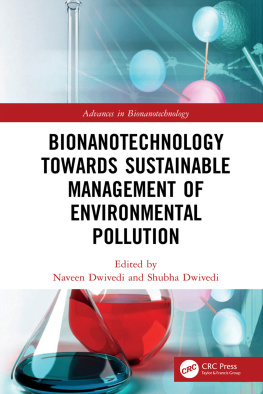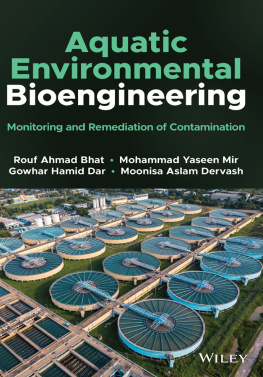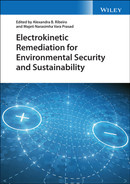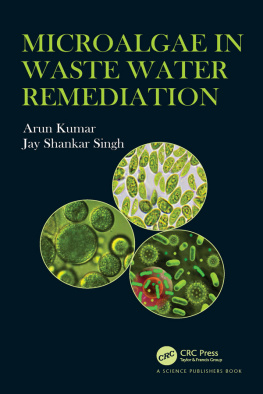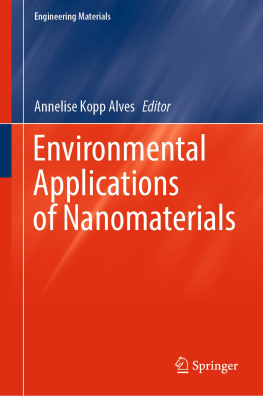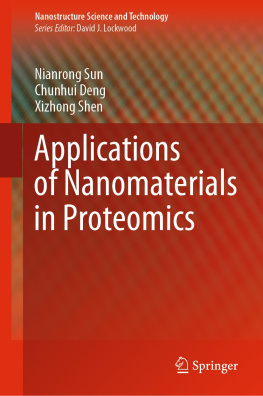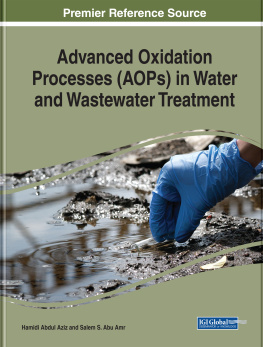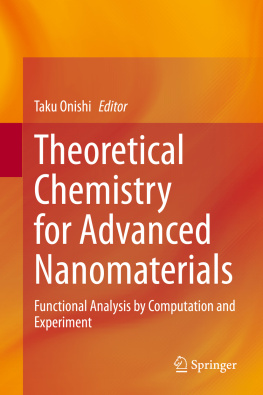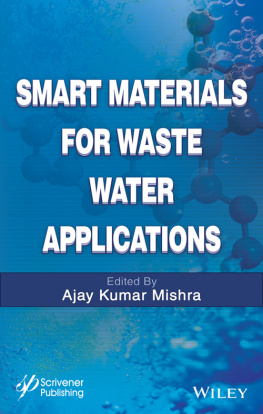Chattopadhyaya Mahesh Chandra - Advanced nanomaterials for wastewater remediation
Here you can read online Chattopadhyaya Mahesh Chandra - Advanced nanomaterials for wastewater remediation full text of the book (entire story) in english for free. Download pdf and epub, get meaning, cover and reviews about this ebook. year: 2017, publisher: CRC Press, genre: Home and family. Description of the work, (preface) as well as reviews are available. Best literature library LitArk.com created for fans of good reading and offers a wide selection of genres:
Romance novel
Science fiction
Adventure
Detective
Science
History
Home and family
Prose
Art
Politics
Computer
Non-fiction
Religion
Business
Children
Humor
Choose a favorite category and find really read worthwhile books. Enjoy immersion in the world of imagination, feel the emotions of the characters or learn something new for yourself, make an fascinating discovery.
- Book:Advanced nanomaterials for wastewater remediation
- Author:
- Publisher:CRC Press
- Genre:
- Year:2017
- Rating:3 / 5
- Favourites:Add to favourites
- Your mark:
- 60
- 1
- 2
- 3
- 4
- 5
Advanced nanomaterials for wastewater remediation: summary, description and annotation
We offer to read an annotation, description, summary or preface (depends on what the author of the book "Advanced nanomaterials for wastewater remediation" wrote himself). If you haven't found the necessary information about the book — write in the comments, we will try to find it.
Advanced nanomaterials for wastewater remediation — read online for free the complete book (whole text) full work
Below is the text of the book, divided by pages. System saving the place of the last page read, allows you to conveniently read the book "Advanced nanomaterials for wastewater remediation" online for free, without having to search again every time where you left off. Put a bookmark, and you can go to the page where you finished reading at any time.
Font size:
Interval:
Bookmark:

Advanced Nanomaterials for Wastewater Remediation
Advances in Water and Wastewater Transport and Treatment
A SERIES
Series Editor
Amy J. Forsgren
Xylem, Sweden
Advanced Nanomaterials for Wastewater Remediation
Ravindra Kumar Gautam and Mahesh Chandra Chattopadhyaya
Membrane Bioreactor Processes: Principles and Applications
Seong-Hoon Yoon
Wastewater Treatment: Occurrence and Fate of Polycyclic Aromatic Hydrocarbons (PAHs)
Amy J. Forsgren
Harmful Algae Blooms in Drinking Water: Removal of Cyanobacterial Cells and Toxins
Harold W. Walker
ADDITIONAL VOLUMES IN PREPARATION
Advanced Nanomaterials for Wastewater Remediation
Edited by
Ravindra Kumar Gautam
Mahesh Chandra Chattopadhyaya

CRC Press
Taylor & Francis Group
6000 Broken Sound Parkway NW, Suite 300
Boca Raton, FL 33487-2742
2017 by Taylor & Francis Group, LLC
CRC Press is an imprint of Taylor & Francis Group, an Informa business
No claim to original U.S. Government works
Printed on acid-free paper
Version Date: 20160414
International Standard Book Number-13: 978-1-4987-5333-3 (Hardback)
This book contains information obtained from authentic and highly regarded sources. Reasonable efforts have been made to publish reliable data and information, but the author and publisher cannot assume responsibility for the validity of all materials or the consequences of their use. The authors and publishers have attempted to trace the copyright holders of all material reproduced in this publication and apologize to copyright holders if permission to publish in this form has not been obtained. If any copyright material has not been acknowledged please write and let us know so we may rectify in any future reprint.
Except as permitted under U.S. Copyright Law, no part of this book may be reprinted, reproduced, transmitted, or utilized in any form by any electronic, mechanical, or other means, now known or hereafter invented, including photocopying, microfilming, and recording, or in any information storage or retrieval system, without written permission from the publishers.
For permission to photocopy or use material electronically from this work, please access www.copyright.com (http://www.copyright.com/) or contact the Copyright Clearance Center, Inc. (CCC), 222 Rosewood Drive, Danvers, MA 01923, 978-750-8400. CCC is a not-for-profit organization that provides licenses and registration for a variety of users. For organizations that have been granted a photocopy license by the CCC, a separate system of payment has been arranged.
Trademark Notice: Product or corporate names may be trademarks or registered trademarks, and are used only for identification and explanation without intent to infringe.
Library of Congress Cataloging-in-Publication Data
Names: Gautam, Ravindra Kumar, editor. | Chattopadhyaya, Mahesh Chandra, editor.
Title: Advanced nanomaterials for wastewater remediation / editors, Ravindra Kumar Gautam and Mahesh Chandra Chattopadhyaya.
Description: Boca Raton : Taylor & Francis Group, a CRC title, part of the Taylor & Francis imprint, a member of the Taylor & Francis Group, the academic division of T&F Informa, plc, [2016] | Series: Advances in water and wastewater transport and treatment ; 4 | Includes bibliographical references and index.
Identifiers: LCCN 2016004617 | ISBN 9781498753333 (acid-free paper)
Subjects: LCSH: Water--Purification--Materials. | Nanostructured materials--Industrial applications. | Nanotechnology.
Classification: LCC TD477 .A38 2016 | DDC 628.3--dc23
LC record available at https://lccn.loc.gov/2016004617
Visit the Taylor & Francis Web site at
http://www.taylorandfrancis.com
and the CRC Press Web site at
http://www.crcpress.com
Dedicated to
My loving sister, the late Pratiksha Gautam
(R.K. Gautam)
And to our
Maa & Baba
Contents
Anupreet Kaur
Debasis Ghosh, Barun Kumar Nandi, Mehabub Rahaman, and Mihir Kumar Purkait
Farshid Ghanbari and Mahsa Moradi
Emilio Rosales, Marta Pazos, and M. ngeles Sanromn
Asif Ali Khan, Shakeeba Shaheen, and Nida Alam
Nalini Sankararamakrishnan
Vinod Kumar Garg and Navish Kataria
Geoffrey S. Simate and Lubinda F. Walubita
Ramasamy Boopathy
Sushmita Banerjee and Ravindra Kumar Gautam
Muhammad Abbas Ahmad Zaini, Lee Lin Zhi, and Tang Shu Hui
Annamalai Sivaraman, Dhevagoti Manjula Dhevi, Arun Anand Prabu, Kap Jin Kim
Sushmita Banerjee, Puja Rai, Vandani Rawat, and Ravindra Kumar Gautam
Heecheul Kim, Dhevagoti Manjula Dhevi, Kap Jin Kim, Arun Anand Prabu, and Xubiao Luo
Anamika Kushwaha, Radha Rani, and Vishnu Agarwal
Water is life. The human body contains, on average, 60% water by weight. The hydrolysis reaction, which is one of the most common reactions that takes place in the human body, requires water for its completion. Thus, of necessity, without pure and nascent water, life will end on our planet. Although it is reported that water was purified in ancient Egypt by using charcoal, it is still used today in different forms to purify water. With the advent of physical and chemical characterization techniques at the atomic level, and the understanding of them through theoretical study in angstrom to nanometer scale, there is an improvement in the understanding of the use of nanotechnology, which can play a pivotal role in improving the standard of life many times over through its application in water, health care, food, and electronics. This book attempts to show the use of nanotechnology in the purification of water. Water is plentifully available on the planet and, thus, we tend to ignore the importance of water treatment and purification and its requirement in daily life. Since water distribution across land masses is quite erratic, it is important that we treat water, recycle, and reuse it as far as possible. It is in this context that the topic chosen by the authors is very relevant in todays world scenario, due to the environmental concern toward both water and air pollution and their nexus to the food chain. I must congratulate the editors and authors who brought together this bouquet of chapters, which encompasses different aspects of wastewater treatment using nanotechnology concepts, and I wish them great success in disseminating the knowledge!
Professor Suddhasatwa Basu, FNASc, FICS
(Former Head of Chemical Engineering Department, I.I.T. Delhi)
(Former Chairman of IIChE NRC)
Chemical Engineering Department
Indian Institute of Technology Delhi
Water is the driving force in nature.
Leonardo da Vinci (14521519)
Contamination of aqueous environments by hazardous chemical compounds has increased tremendously during the last couple of decades, due to enhanced industrialization, burgeoning urbanization, and the haphazard growth of the world population. Thus, the supply of clean water has declined rapidly throughout the globe to meet the recommended safe limits. Pollution by metals, metalloids, dyes, volatile organic compounds, and other inorganic and organic salts is one of the most widespread concerns of aquatic ecosystems. Many of them are difficult to biodegrade, possess high solubility in water, and facilitate increased mobilization in abiotic and biotic environments, thus threatening human health and aquatic organisms. As a consequence of growing pressure on the water supply in drought-prone areas, and for industrial and civil purposes, the use of unconventional water sources such as treated wastewater will be a new norm. Hence, various remediation measures such as membrane filtration, coagulationflocculation and oxidationreduction processes, bioremediation, and adsorption have been examined regarding the separation and purification of contaminated aqueous environments. All these technological innovations have their own benefits and drawbacks.
Font size:
Interval:
Bookmark:
Similar books «Advanced nanomaterials for wastewater remediation»
Look at similar books to Advanced nanomaterials for wastewater remediation. We have selected literature similar in name and meaning in the hope of providing readers with more options to find new, interesting, not yet read works.
Discussion, reviews of the book Advanced nanomaterials for wastewater remediation and just readers' own opinions. Leave your comments, write what you think about the work, its meaning or the main characters. Specify what exactly you liked and what you didn't like, and why you think so.


